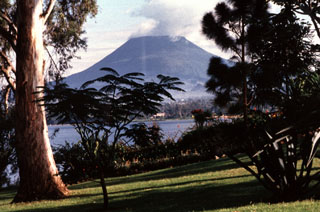Report on Nyiragongo (DR Congo) — 22 February-28 February 2023
Smithsonian Institution / US Geological Survey
Weekly Volcanic Activity Report, 22 February-28 February 2023
Managing Editor: Sally Sennert.
Please cite this report as:
Global Volcanism Program, 2023. Report on Nyiragongo (DR Congo) (Sennert, S, ed.). Weekly Volcanic Activity Report, 22 February-28 February 2023. Smithsonian Institution and US Geological Survey.
Nyiragongo
DR Congo
1.52°S, 29.25°E; summit elev. 3470 m
All times are local (unless otherwise noted)
The Observatoire Volcanologique de Goma (OVG) reported that the lava lake on Nyiragongo’s crater floor continued to be active during 13-19 February; faint glow emanated from the crater on 15 February. Seismicity was generally low, characterized by a few long-period earthquakes located up to 15 km deep along the large fracture connecting the Nyamuragira and Nyiragongo. A seismic station near the volcano registered a minor increase in the intensity of signals on 17 February. High concentrations of carbon dioxide were measured in the Mazuku areas, and in an area to the W of a camp in the Lac Vert district in Bulengo; OVG warned residents to stay away from those areas. The Alert Level remained at Yellow.
Geological Summary. The Nyiragongo stratovolcano contained a lava lake in its deep summit crater that was active for half a century before draining catastrophically through its outer flanks in 1977. The steep slopes contrast to the low profile of its neighboring shield volcano, Nyamuragira. Benches in the steep-walled, 1.2-km-wide summit crater mark levels of former lava lakes, which have been observed since the late-19th century. Two older stratovolcanoes, Baruta and Shaheru, are partially overlapped by Nyiragongo on the north and south. About 100 cones are located primarily along radial fissures south of Shaheru, east of the summit, and along a NE-SW zone extending as far as Lake Kivu. Many cones are buried by voluminous lava flows that extend long distances down the flanks, which is characterized by the eruption of foiditic rocks. The extremely fluid 1977 lava flows caused many fatalities, as did lava flows that inundated portions of the major city of Goma in January 2002.

